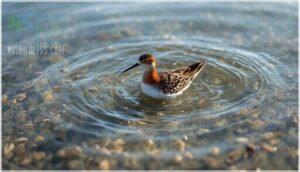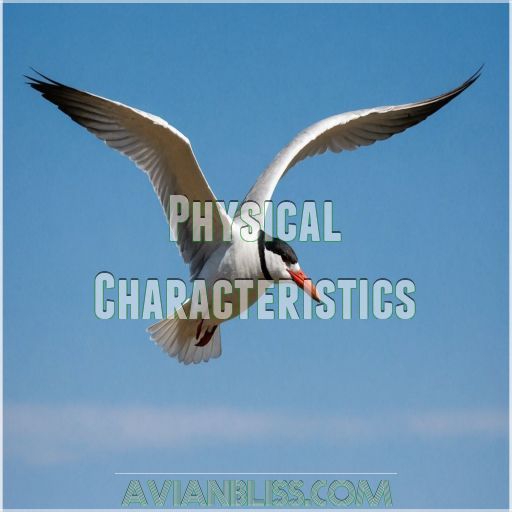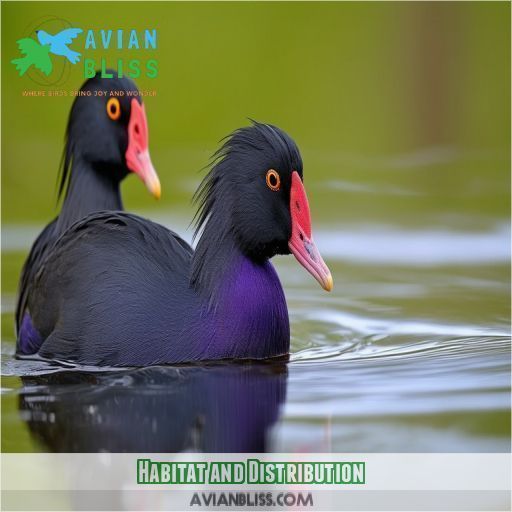This site is supported by our readers. We may earn a commission, at no cost to you, if you purchase through links.

Ostriches are the real giants, standing up to 9 feet tall and weighing in at a whopping 320 pounds.
Emus, while still pretty big, only reach about 6.2 feet and 125 pounds.
Both birds can really move, with ostriches hitting speeds of 45 mph and emus sprinting at 30 mph.
Male emus are the ones who sit on the eggs and take care of the chicks, while male ostriches have a bunch of female mates.
There’s a lot more to learn about these flightless birds – keep reading to discover their fascinating world!
Table Of Contents
- Key Takeaways
- Emu Vs Ostrich: Size Comparison
- Speed and Agility
- Reproduction and Nesting
- Lifespan and Longevity
- Egg-Laying and Incubation
- Diet and Foraging
- Physical Characteristics
- Habitat and Distribution
- Behavior and Social Structure
- Unique Features and Facts
- Frequently Asked Questions (FAQs)
- What is the difference between an emu and an ostrich?
- Are emus less aggressive than ostriches?
- Who would win ostrich vs emu?
- Are emus faster than ostriches?
- Can emus and ostriches interbreed?
- Which bird has better eyesight, emus or ostriches?
- Are emus or ostriches more intelligent?
- How do emus and ostriches respond to humans?
- Which bird is easier to domesticate and farm?
- Conclusion
Key Takeaways
- You’ll notice that ostriches are the clear giants in the emu vs ostrich showdown, growing up to 9 feet tall and weighing a whopping 320 pounds, while emus reach a maximum height of 6.2 feet and weigh up to 125 pounds—that’s like comparing a basketball player to a gymnast!
- When it comes to speed, ostriches leave emus in the dust, sprinting up to 45 mph, while emus top out at 30 mph—it’s like the difference between a sports car and a family sedan!
- You’ll be surprised to learn that male emus are the ultimate single parents, incubating eggs and caring for chicks, while male ostriches are the polygamous kings of the savannah, mating with multiple females and leaving the childcare to them—talk about a role reversal!
- Despite their differences, both emus and ostriches have some remarkable adaptations that help them thrive in their environments, from powerful legs and sharp claws to unique feather structures and clever foraging strategies—these birds are the ultimate survivors!
Emu Vs Ostrich: Size Comparison
You’re about to witness the ultimate showdown between two of the world’s most fascinating birds – the emu and the ostrich. Let’s start with the most obvious difference: size, where ostriches can grow up to 9 feet tall and weigh as much as 320 pounds, while emus reach a maximum height of 6.2 feet and weigh up to 125 pounds.
Ostrich Measurements
Regarding ostrich measurements, you’ll be amazed by their towering height and massive weight. On average, male ostriches can grow up to 2.8m tall and weigh between 63-145kg. Here are three key facts about ostrich size:
- Leg Length Comparison: Ostriches have incredibly long legs, with some males having legs as long as 2m.
- Height Variations: Female ostriches are slightly shorter, reaching heights of 1.7-2.0m.
- Weight Distribution: Ostriches have a remarkable weight distribution, with their powerful legs supporting their massive body mass.
Emu Measurements
Now that we’ve covered ostrich measurements, let’s talk about emu measurements. Emus are noticeably smaller than ostriches, but still quite impressive. Here’s a comparison of their measurements:
| Characteristics | Emu | Ostrich |
|---|---|---|
| Height | 1.56m – 1.9m | 2.1m – 2.8m |
| Leg Length | 70cm – 80cm | 100cm – 120cm |
| Body Mass Ratio | 18kg – 60kg | 63kg – 145kg |
Notice the difference in leg length and body mass ratio.
Weight and Height Differences
Let’s get to the nitty-gritty of emu vs ostrich size differences. You might be wondering, just how big are these birds? Here are some key differences:
- Ostriches weigh between 63 and 145kg, while emus average between 18 and 60kg .
- Ostriches can grow up to 9 feet tall, while emus reach a maximum height of 6.2 feet .
- Emus are generally smaller, with a more rounded body shape (Source).
Speed and Agility
You’re about to witness the ultimate showdown in speed and agility – emus versus ostriches! Get ready to find out which of these two bird species can run the fastest and maintain their pace over long distances, with some surprising facts that’ll leave you amazed at their athleticism.
Ostrich Running Speed
You’re about to witness the ultimate speed demon – the ostrich! Reaching mind-boggling speeds of up to 45mph, these birds are the Usain Bolts of the savannah. Their powerful leg anatomy, featuring two long legs and strong feet, enables them to cover 5 meters in a single stride. That’s some serious stride efficiency, folks!
Emu Running Speed
Let’s talk emu running speed! You might be surprised to know that emus can sprint at an impressive 30 miles per hour.
Their athletic abilities are quite remarkable, with some individuals showcasing a speed variance of up to 5 miles per hour.
While they may not be the fastest birds on land, their endurance is notable, making them agile and swift flightless birds.
Stride Length and Endurance
You’re amazed by the emu’s running speed, but what about its stride length and endurance? Let’s break it down:
- Emus cover 3-4 meters per stride, while ostriches cover a whopping 5 meters!
- Energy expenditure: Emus use more energy for shorter strides, while ostriches conserve energy with longer strides.
- Muscle structure: Ostriches have more powerful leg muscles, perfect for endurance.
- Physiological differences: Emus have a higher metabolic rate, making them more agile, while ostriches are built for long-distance running.
Reproduction and Nesting
You’re about to enter the fascinating world of emu and ostrich reproduction, where the rules of courtship and parenting are turned upside down.
In this unique landscape, male emus incubate eggs and brood chicks.
Male ostriches dominate the mating scene with their impressive size and plumage, but don’t let traditional sizes fool you – female emus are the true power players here.
Get ready to discover the unique mating habits, role reversals, and parental responsibilities that set these two birds apart in the world of reproduction and nesting.
Male and Female Roles
You’re about to see a role reversal like no other. When it comes to emus and ostriches, traditional male and female roles are turned upside down.
| Bird Species | Male Role | Female Role |
|---|---|---|
| Emu | Incubates eggs, cares for chicks | Dominant, mates with multiple males |
| Ostrich | Dominant, mates with multiple females | Incubates eggs, cares for chicks |
Reproduction and Nesting
| Ostriches | Emu | ||
|---|---|---|---|
| Male role | Mating with multiple females | Incubating eggs and brooding chicks | |
| Female role | Mating with multiple males | Laying eggs and seeking new mates | |
| Parental care | Both males and females care for chicks | Males care for chicks, females may seek new mates | |
| Nest building | Both males and females build nests | Females build nests, males may help | |
| Chick rearing | Both males and females care for chicks | Males care for chicks, females | may seek new mates |
You’ll see big differences in how emus and ostriches reproduce and nest. Ostriches have more complex social structures, with males and females playing different roles.
Mating Habits
You’re about to witness the wild world of emu and ostrich mating habits!
Emus are polyandrous, with females choosing multiple mates and engaging in elaborate courtship displays.
Meanwhile, ostriches are polygamous, with dominant males leading a harem of females.
Both species select nesting sites carefully, but the similarities end there.
Get ready to explore the fascinating world of ratite romance!
Emus are known for their unique courtship displays, whereas ostriches have a complex harem dynamic.
Male emus perform impressive displays to attract females, while ostrich males compete for dominance within their harems.
Both species show a strong mate preference, with males often choosing specific females.
Nature’s own drama unfolds!
Incubation and Brooding
You’re now a part of the fascinating world of emu and ostrich reproduction. These birds have some remarkable strategies when it comes to incubation and brooding:
- Emu males take on the responsibility of incubating eggs, balancingAs you explore the fascinating world of emus and ostriches, you’ll discover that their reproductive habits are just as intriguing as their physical differences. Here’s a breakdown of their incubation and brooding behaviors:
- Emu eggs are dark green, weighing around 1 feet-1.4 pounds.
- Ostrich eggs are cream-colored, and weighing up to 3 pounds.
- Both species bury their heads in the ground to check on their eggs and regulate their temperature.
- Female emus are dominant and polyandrous, mating a with multiple males, while male ostriches are dominant and polygamous, mating with a harem of 3- fold8 females.
Lifespan and Longevity
As you explore the fascinating world of emus and ostriches, you’ve likely wondered how their lives unfold. Did you know that emus and ostriches have vastly different lifespans, with some ostriches living up to 50 years, while emus typically live for around 20 years?
Average Lifespan of Emus
As you explore the fascinating world of emus, you’re probably wondering about their average lifespan. In the wild, emus typically live between 10 to 20 years, while in captivity, they can thrive for up to 30 years. Factors such as diet, habitat, and disease can impact their longevity, but with proper care, emus can live a long and healthy life.
Average Lifespan of Ostriches
Let’s talk ostrich lifespan! In the wild, these magnificent birds can live up to 30-40 years (Source). But, in captivity, they’ve been known to live a whopping 50-60 years or more . That’s impressive, right? Now, you might wonder, how do emus compare? Well, we’ve already discussed that, but ostriches clearly have a longer lifespan (Source).
Factors Affecting Lifespan
Ever wondered why some emus and ostriches live longer than others? It’s not just luck!
Habitat plays a huge role – a cozy home means a longer life.
Diet‘s another biggie; these birds need their greens (and protein for ostriches).
Watch out for predators, they’re the party-poopers of longevity.
Disease and stress can also cut the fun short.
Egg-Laying and Incubation
You might think all bird eggs are pretty similar, but emus and ostriches have some eye-opening differences in terms of their eggs and nesting habits. Let’s crack open this topic and explore the fascinating world of egg-laying and incubation for these two impressive birds.
Egg Size and Color
You’ll be amazed at the egg-cellent differences between emu and ostrich eggs!
Emu eggs are dark green with blue specks, like nature’s Easter eggs.
They’re hefty, weighing up to 1.4 pounds.
Ostrich eggs, on the other hand, are off-white giants, tipping the scales at a whopping 3 pounds!
These prehistoric-looking orbs could make one heck of an omelet.
Both eggs pack a nutritional punch, but the ostrich egg takes the cake in size.
Incubation Period
You’d be amazed at the egg-sitting marathon these birds endure. Ostriches play the long game, incubating their eggs for a whopping 42 days. Emus aren’t far behind, clocking in at 56 days.
It’s like a feathered version of "The Tortoise and the Hare," but with both birds taking their sweet time.
During this period, they’re masters of egg temperature control, ensuring their little ones have the best shot at hatching success.
Nesting Habits
You’ll be amazed by the nesting habits of emus and ostriches! These feathered giants have some quirky tricks up their sleeves regarding egg-laying and incubation. Here’s the scoop on their nesting behavior:
- Emus lay dark green eggs, while ostriches opt for cream-colored beauties
- Both birds dig shallow nests in the ground talk about down-to-earth parenting!
- Ostrich dads take the night shift, moms handle daycare
- Emu dads are superstar single parents, incubating and raising chicks solo
- Sometimes, these birds form "daycare centers" with merged broods
Diet and Foraging
You might think all big birds eat the same things, but emus and ostriches have surprisingly different diets. Let’s explore what these feathered giants munch on and how they find their food in the wild.
Emu Diet
Ever wondered what’s on an emu’s menu? These Aussie giants aren’t picky eaters!
They’ll munch on plants, seeds, and fruits, but they’re not above snagging the occasional insect for a protein boost.
Emus are masters of adaptability, adjusting their diet with the seasons. Their powerful beaks and sharp claws make foraging a breeze, whether they’re pecking at grass or digging up tasty roots.
Talk about a bird that knows how to feast!
Ostrich Diet
Unlike their emu cousins, ostriches are true foodies of the bird world.
These Desert dwellers don’t just stick to salads – they’re omnivores with a taste for adventure!
You’ll find them munching on plants, sure, but they’re not above snacking on insects or even small reptiles.
Talk about a diverse palate!
Their diet changes with the seasons, keeping them on their toes (or should we say, claws?).
Foraging Habits
You’d be amazed at how these big birds forage!
Emus are like nature’s vacuum cleaners, scooping up seeds, fruits, and insects as they roam.
Ostriches, on the other hand, are the ultimate food critics of the savanna, sampling everything from plants to small reptiles.
Both birds have adapted to their habitats, with emus tackling Australia’s diverse landscapes and ostriches mastering the art of desert dining.
Talk about power lunches in the wild!
Physical Characteristics
You might think you know the difference between emus and ostriches, but their physical characteristics will leave you amazed. From their distinctive plumage to their unique foot structures, these flightless birds have some jaw-dropping features that set them apart.
Plumage and Feathers
You’ve learned about their diets, but let’s ruffle some feathers and talk plumage! Emus and ostriches may both be flightless, but their feathers tell different stories. Here’s a quick breakdown:
- Emu feathers: Dark brown to black, with a shaggy appearance
- Ostrich plumage: Black body with white wing and tail plumes (males)
- Emu down: Soft and fluffy, perfect for insulation
- Ostrich feathers: Longer and more elaborate, once prized in fashion
These feather adaptations help them thrive in their respective habitats.
Beak Shape and Size
You might think all bird beaks are created equal, but emus and ostriches have some surprising differences up their beaks.
Emu beaks are slim and slightly curved, perfect for plucking plants and catching insects. Ostrich beaks, on the other hand, are flatter and broader, ideal for grazing and gobbling up small prey.
These beak adaptations showcase how these ratite relatives have evolved to thrive in their unique environments. Talk about a bird’s-eye view of evolution!
Leg and Foot Structure
You’ll notice that ostriches are the two-toed wonders of the bird world, while emus rock three toes. It’s like nature’s version of rock-paper-scissors!
Both birds have incredibly strong legs, perfect for kicking butt (literally) and running like the wind.
Their unique toe configurations and tendon structures are evidence of flightless bird evolution. Talk about putting your best foot forward!
Habitat and Distribution
You might think these giant birds live in similar places, but emus and ostriches are worlds apart in terms of their homes. Let’s explore the surprising differences in where these feathered giants roam and how their habitats shape their unique characteristics.
Emu Habitat
Now, let’s shift gears and explore the emu’s stomping grounds.
These Aussie giants aren’t picky – they’ll make themselves at home in grasslands, savannas, and open woodlands across the continent.
Talk about adaptable! Emus have evolved to thrive in Australia’s harsh climate, laughing in the face of scorching heat and unpredictable weather.
They’re not just surviving; they’re thriving in a land where even the plants can be deadly.
How’s that for power?
Ostrich Habitat
You’ll be amazed by how well-adapted ostriches are to their African habitats! These incredible birds thrive in:
- Scorching savannas
- Arid deserts
- Grassy plains
- Open woodlands
Their unique coloration helps them blend in, avoiding predators like a pro. Ostriches have evolved to survive in harsh environments, sipping dew from plants and munching on tough vegetation. Talk about resilience! It’s no wonder these feathered powerhouses have become the stars of ostrich farms worldwide.
Geographic Range
While ostriches roam Africa’s savannas, you’ll find emus strutting their stuff in Australia. These two flightless wonders couldn’t be further apart! Let’s break down their stomping grounds:
| Feature | Emu | Ostrich | Overlap |
|---|---|---|---|
| Continent | Australia | Africa | None |
| Climate | Varied | Mostly arid | Some |
| Terrain | Grasslands, woodlands | Savannas, deserts | Grasslands |
| Adaptations | Heat-tolerant | Drought-resistant | Both hardy |
| Conservation | Least concern | Vulnerable | Different challenges |
Talk about long-distance relationships! These birds have evolved worlds apart, each carving out their own niche.
Behavior and Social Structure
You’re in for a treat as we explore the fascinating world of emu and ostrich behavior. Get ready to discover how these feathered giants interact with their own kind and the unique social structures that shape their lives.
Emu Behavior
Emus are known for their quirky behavior and serious sass. Their deep, booming calls can be heard for miles, like nature’s own subwoofer.
When threatened, emus are not afraid to throw down with powerful kicks.
Emus are social birds, forming tight-knit flocks with a pecking order that’s reminiscent of high school cliques.
During nesting season, emus become fiercely protective parents, guarding their eggs with determination.
Ostrich Behavior
You’ll be amazed by ostrich behavior! These feathered giants are full of surprises. Here’s what you need to know:
- They’re not shy about their mating rituals – males strut their stuff with wing-flapping dances.
- Don’t mess with them – their defensive tactics include powerful kicks.
- Dads take charge of parental care, incubating eggs and protecting chicks.
- They’re masters of territorial displays, hissing and spreading wings to look intimidating.
Ostriches are like nature’s superheroes, with attitude to match their size!
Social Structure and Flocking
You’ll be amazed by the social structure of these feathered giants.
While ostriches are the life of the party, forming flocks of up to 50 birds, emus prefer a more intimate gathering of 5 to 50.
Both species have a pecking order, but ostriches take it to the next level with their harems.
Talk about a bird’s-eye view of power dynamics! These social butterflies of the avian world sure know how to ruffle some feathers.
Unique Features and Facts
You might think you know all about emus and ostriches, but these birds have some truly surprising features that’ll blow your mind. From unique eye structures to unexpected neck colors, let’s explore the fascinating world of these flightless wonders and uncover some jaw-dropping facts you never knew existed.
Emu Facts
- Emus make a booming call that sounds like a drum
- They’re excellent swimmers and love taking dips
- Emu farming is popular for their meat and oil
- They can sprint at speeds up to 31 mph
- Emus have excellent eyesight and can see up to 50 meters away
Ostrich Facts
You’ll be amazed by these ostrich facts! These giants of the bird world are full of surprises. Did you know they can’t fly, but they’re lightning-fast runners? Check out this table of mind-blowing ostrich stats:
| Fact | Detail |
|---|---|
| Top speed | 45 mph |
| Lifespan | Up to 50 years |
| Egg weight | Up to 3 pounds |
| Population estimate | Around 150,000 |
Talk about impressive! These feathered powerhouses have been around for millions of years, evolving into the speedy, long-legged creatures we see today.
Interesting Comparisons
You’ve seen how ostriches and emus stack up, but here’s a fun twist: did you know that emus can’t walk backward?
It’s true!
Meanwhile, ostriches have been known to use their wings like rudders when running.
Talk about evolution in action!
Both birds have adapted to their environments in fascinating ways.
Whether you’re into bird farming or curious about aboriginal treatments, these flightless wonders never cease to amaze.
Frequently Asked Questions (FAQs)
What is the difference between an emu and an ostrich?
Did you know ostriches can run 45 mph, while emus top out at 30? You’ll spot key differences in size, speed, and habitat. Ostriches are Africa’s desert giants, while emus rule Australia’s grasslands. Both are flightless wonders!
Are emus less aggressive than ostriches?
You’ll find emus are generally less aggressive than ostriches. While both can defend themselves, ostriches are known for their feisty nature. Don’t let your guard down, though – an angry emu can still pack a punch!
Who would win ostrich vs emu?
Ever wondered who’d win in a battle of the birds? You’d likely see the ostrich emerge victorious. They’re larger, faster, and pack a more powerful kick. But don’t count the emu out – they’re scrappy fighters too!
Are emus faster than ostriches?
No, emus aren’t faster than ostriches. You’ll find ostriches can sprint up to 45 mph, while emus max out around 30 mph. It’s like comparing a sports car to a family sedan – both quick, but one’s built for speed!
Can emus and ostriches interbreed?
Imagine two birds from different worlds, trying to tango – it’s a beautiful mess! Unfortunately, emus and ostriches can’t interbreed, as they belong to different species with distinct genetic makeups, making it a reproductive mismatch.
Which bird has better eyesight, emus or ostriches?
You’re curious about which bird has better eyesight. Well, ostriches have the largest eyes of any bird, with a field of vision of almost 360 degrees , but there’s no clear winner in an emu-ostrich eyesight showdown.
Are emus or ostriches more intelligent?
You’re wondering which bird brain is brighter? Well, research suggests ostriches might’ve a slight edge in intelligence, but emus are no featherbrained friends either – both are known for their clever adaptability and quick thinking!
How do emus and ostriches respond to humans?
When interacting with humans, you’ll find that emus can be quite curious and may even approach you, while ostriches tend to be more cautious and may become aggressive if they feel threatened or cornered.
Which bird is easier to domesticate and farm?
Imagine raising a bird that’s as tall as a small car! You’ll want to think about the emu, which is relatively easier to domesticate and farm due to its smaller size and more docile nature compared to ostriches.
Conclusion
Now that you’ve explored the fascinating world of these massive birds, it’s clear that the emu vs ostrich debate is more than just a size comparison.
You’ve discovered the remarkable differences in their speed, reproduction habits, lifespan, and even unique features like egg-laying and foraging behaviors.
As you walk away with a new appreciation for these flightless wonders, remember that the emu vs ostrich showdown is a clear example of nature’s incredible diversity.













